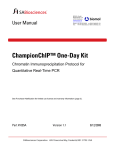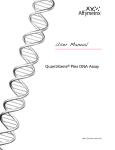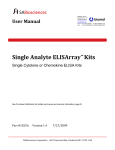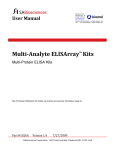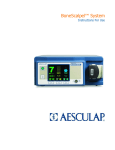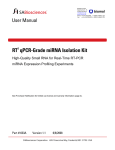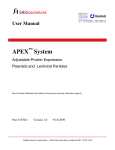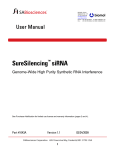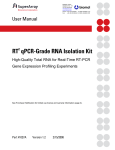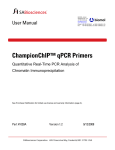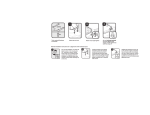Download User Manual - Biomol GmbH
Transcript
BIOMOL GmbH Waidmannstr. 35 22769 Hamburg [email protected] www.biomol.de Phone:+49-40-8532600 or 0800-2466651 (D) Fax: +49-40-85326022 or 0800-2466652 (D) User Manual ChampionChIP™ Prep Kit One-Day Preparative Protocol of Chromatin Immunoprecipitation Samples for Quantitative Real-Time PCR See Purchaser Notification for limited use license and warranty information (page 3). Part #1035A Version 1.0 7/18/2008 ChampionChIP™ Prep Kit One-Day Preparative Protocol of Chromatin Immunoprecipitation Samples for Quantitative Real-Time PCR User Manual (For Catalog Number: GA-101) Ordering and Technical Service Contact Information: • • • • Tel: Fax: On-line Order: E-MAIL: 1-888-503-3187 (US) 301-682-9200 (outside US) 1-888-465-9859 (US) 301-682-7300 (outside US) www.sabiosciences.com order@ sabiosciences.net (to place an order) support@ sabiosciences.net (for technical support) You may place orders by fax, e-mail or from our website. Each order should include the following information: • • • • • Your contact information (name, phone, email address) Product name, catalog number and quantity Purchase order number or credit card information (Visa or MasterCard) Shipping address Billing address For more information, visit us at www.sabiosciences.com BIOMOL GmbH Waidmannstr. 35 22769 Hamburg [email protected] www.biomol.de Phone:+49-40-8532600 or 0800-2466651 (D) Fax: +49-40-85326022 or 0800-2466652 (D) SABiosciences Corporation 6951 Executive Way Frederick, MD 21703 USA CONTENTS I. Background and Introduction 4 II. Materials Provided 6 III. Additional Materials Required 7 V. Protocol 8 A. ChIP-Ready Chromatin Preparation 8 B. Protein/DNA Immunoprecipitation (IP) 10 C. DNA Isolation & Purification 12 D. ChIP DNA Detection & Data Analysis 13 VI. Troubleshooting & FAQ 14 Appendix: Chromatin Shearing Optimization 15 LIMITED PRODUCT WARRANTY This product is intended for research purposes only and is not intended for drug or diagnostic purposes or for human use. This warranty limits our liability to replace this product in the event the product fails to perform due to any manufacturing defect. SABiosciences Corporation makes no other warranties of any kind, expressed or implied, including without limitation, warranties of merchantability or fitness for a particular purpose. SABiosciences Corporation shall not be liable for any direct, indirect, consequential or incidental damages arising out of the use, the results of use or the inability to use this product. NOTICE TO PURCHASER The purchase of ChIP Preparation Kit includes a limited, nonexclusive license to use the kit components for research use only. This license does not grant rights to use the kit components for reproduction of the kit, to modify kit components for resale or to use the ChIP Preparation Kit to manufacture commercial products without written approval of SABiosciences Corporation. No other license, expressed, implied or by estoppels, is granted. 3 I. Background and Introduction Chromatin Immunoprecipitation (ChIP) is rapidly becoming a very important method for understanding the mechanisms of gene regulation by transcription factors and modified histones. However, this preparative process is very tedious and time-consuming to perform, involving many steps and variables that must be optimized by each investigator in their model system. After crosslinking cells with formaldehyde, chromatin containing covalent complexes between genomic DNA and all nuclear factors is isolated and sheared by sonication into manageable sizes. Immunoprecipitation pulls down not only the target nuclear factor of interest but also any specifically bound genomic DNA sequences. Reversal of the chemical crosslinking and nucleic acid purification prepare the DNA for detection by sequencing, hybridization-based microarrays, or PCR. To help researchers, a number of commercial preparation kits are available that include all the reagents needed for this process. While some of these kits still rely on the traditional multi-day protocol to isolate ChIP DNA, others offer an innovative one-day solution. However, most kits demonstrate the success of the experiment with agarose gel-based electrophoresis rather than the gold-standard for nucleic acid detection, real-time PCR. Our ChIP Prep Kit is designed to help any biological researcher isolate and purify DNA bound to their nuclear factor of interest with the quality required by real-time PCR detection. The complete preparation kit includes all buffers and components needed for immunoprecipitation, crosslink reversal, and genomic DNA purification for detection. The general, universal kit also offers compatibility with any chosen ChIP-grade antibody. Otherwise, all you need is crosslinking agent, a sonicator, and your cell-based experiment. The protocol and reagents have been carefully optimized to take most of the guesswork out of ChIP preparation. Tips and hints are also provided in the protocol for optimizing your cell harvesting and sonication conditions, steps that you must control and the kit cannot. The entire protocol can be completed in one day, but also includes convenient stopping points for continuing the protocol the next day. The resulting DNA is free of contaminants that confound and interfere with real-time PCR detection, in particular using the ChIP-qPCR Assays. Benefits of the ChIP Prep Kit: • Universality: General preparation kit compatible with any ChIP-Grade antibody • Speed & Ease: Simplified protocol removes the guesswork • High Performance: Higher-yield and higher-quality DNA for real-time PCR 4 Version 1.0 II. Materials Provided: Please check the kit components immediately after you receive this package. We are not responsible for any missing items not reported within two (2) business days upon receipt. Tube ID E01 PIC E02 E03 E04 E07 E21 E22 E23 E24 E30 E31 E32 E33 E34 Contents 10X PBS Protease Inhibitor Cocktail 10X Stop Buffer IP Lysis Buffer IP Buffer A Protein A Beads IP Wash Buffer I IP Wash Buffer II IP Wash Buffer III IP Wash Buffer IV ChIP-Grade Proteinase K DNA Extraction Beads Elution Buffer Column Binding Buffer Column Wash Buffer DNA Spin Columns Non-Stick Elution Tubes (1.7-mL) 2-mL Tubes (Sonication) 5-mL Tubes (Pre-Clear) Quantity One 30-mL Bottle One 1.5-mL Clear-Capped Tube One 15-mL Bottle One 15-mL Bottle One 15-mL Bottle One 2-mL Blue-Capped Tube One 15-mL Bottle One 15-mL Bottle One 15-mL Bottle One 30-mL Bottle One 1.5-mL Red-Capped Tube One 2-mL Green-Capped Tube Three 2-mL Yellow-Capped Tubes One 15-mL Bottle One 15-mL Bottle One Bag of 12 Columns Three Bags of 12 Tubes One Bag of 6 Tubes One Bag of 6 Tubes STORE AT -20 °C! CENTRIFUGE! STORE AT -20 °C! CENTRIFUGE! Storage Conditions: The True Easy ChIP Prep Kit is shipped with ice packs. Protease Inhibitor Cocktail (PIC) & ChIP-Grade Proteinase K (E30) must be stored at -20 °C. All other components must be stored at 4 °C in their original container to insure that no components are misplaced. Upon arrival, centrifuge Protein A Beads (E07) and DNA Extraction Beads (E31) at 4000 x g for 1 min at 4 ºC and return to their original position in the box. Shelf Life: All reagents are stable for 6 months after receipt of the kit if stored at the recommended temperature. Technical Support: 888.503.3187 (US) 5 301.682.9200 ChampionChIP™ Chromatin Immunoprecipitaion Preparation Kit III. Additional Materials & Equipment Required: Additional Materials Required: The following components are needed for the protocol, but are not included in the kit. • 37 % Formaldehyde (Sigma, Catalog Number F1635) • Silicone Cell Scraper or Rubber Policeman (VWR) • Filter Tips • P-200 large bore/wide-mouth pipette tip (VWR, Cat# 46620-642 in North America or 732-0544 in Europe) • Wet ice / ethanol bath or wet ice bath Equipment Required: • Sonicator • Rotator • Thermomixer® (Eppendorf) or shaking water bath • UV Spectrophotometer • Centrifuge • Bench-top Microcentrifuge • Rotating Platform at 4 °C and room temp • Real-Time PCR Instrument 6 Version 1.0 IV. Protocol: Notes on Sample Preparation: The protocol for sample preparation depends on the nature or source of the sample itself, and the experiment design. Generally, each ChIP Assay needs at least two ChIP fractions (one mock or negative control and one for the target of interest), and sometimes an optional third fraction as a positive control (for example, RNA Polymerase II). Each ChIP fraction requires 1 2 million cells. This protocol is based on the use of 4 – 6 million adherent mammalian cells from one experimental sample, enough for 3 to 4 ChIP fractions. Please scale all recipes down or up according to the number of cells that you are harvesting. A. ChIP-Ready Chromatin Preparation: This section describes the preparation of ChIP-Ready Chromatin. It covers cell cross-linking, harvesting, lysis, and chromatin shearing based on adherent mammalian cell lines. Certain steps may need to be optimized for experiment-dependent performance. This protocol also provides several stopping points for the flexibility to optimize those steps. 1. Cross-Linking Cells a. Grow cells under normal conditions to 70-85% confluence. For example, HeLa cells at 70-85% confluence on a 10-cm dish number roughly 4 to 6 million cells. Prepare one extra plate of cells to estimate cell number, if necessary. b. Before harvesting cells, prepare following buffers, scale up accordingly if necessary. i. 1X PBS Buffer: Add 3.3 mL 10X PBS (E01) to 29.7 mL ddH2O. Mix well and place on ice. ii. FRESH Fixing Buffer (1 % Formaldehyde): Add 0.27 mL 37 % Formaldehyde to 9.73 mL 1 × PBS Buffer. Mix and store at room temperature in a fume hood. iii. Cell Harvesting Buffer: Add 15 μL Protease Inhibitor Cocktail (PIC) to 3 mL ice-cold 1 × PBS Buffer. Mix well and place on ice. c. Aspirate cell culture medium from the dish. Add 10 mL FRESH Fixing Buffer to the dish. Incubate at 37°C for 10 minutes. d. Add 1.1 mL Stop Buffer (E02) to the dish and swirl to mix thoroughly. Incubate at room temperature for 5 minutes. Aspirate as buffer as much as possible. NOTE: From this point forward, keep the samples on ice at all times. e. Wash the fixed cells with 10 mL ice cold 1X PBS, rocking the dish for 5 seconds. Pour off the wash buffer. Repeat once more. Aspirate as much buffer as possible. Technical Support: 888.503.3187 (US) 7 301.682.9200 ChampionChIP™ Chromatin Immunoprecipitaion Preparation Kit 2. Harvesting Cells a. Add 0.8 mL ice-cold Cell Harvesting Buffer to the dish. Scrape cells with a silicone cell scraper or rubber policeman. Place dish on ice at an angle to scrape suspended cells down to one edge of the dish. Transfer the cell suspension to a 2-mL Sonication Tube on ice. b. Add another 0.7 mL ice-cold Cell Harvesting Buffer and repeat cell scrape as above. Transfer and pool the cell suspension into the same 2-mL Sonication Tube. c. Pellet the cells by centrifuging at 800 × g for 10 min at 4 °C. Remove the supernatant. d. Repeat harvesting and centrifugation steps as many times as necessary to collect all of the cells. Otherwise, continue with next step OR store at -80°C. 3. Cell Lysis a. If samples were previous frozen and stored, thaw on ice. Add 2.2 μL Protease Inhibitor Cocktail (PIC) to 420 μL IP Lysis Buffer (E03) in a standard 1.5-ml Eppendorf tube. Mix well by pipetting up and down. b. Add entire volume of IP Lysis Buffer with PIC to the cell pellet (100 μL IP Lysis Buffer with PIC for every 0.5 to 1.5 million cells). Resuspend cells completely by pipetting up and down. Incubate on ice for 10 – 15 min, pipetting every 5 minutes. Continue with next step OR store at -80°C. 4. Shearing Chromatin NOTE: This protocol describes recommendations for the Sonicator 3000 (MISONIX, Part# S3000) with a 1/16” microtip. The sonication conditions need to be optimized for different sonicators and different cell lines. The final cross-linked, sheared chromatin DNA should have an average size between 1 to 3 kb, and be no larger than 10 kb as characterized on a 1.2 % agarose gel. Please see Appendix A for details on optimizing this step. a. Thaw cell lysate on ice if necessary. Place the sample tube in a wet ice / ethanol bath or wet ice bath. b. Insert the probe (1/16” microtip) to a 2 - 3 mm depth into the cell lysate. c. Shear cell lysate using optimized conditions. For example, cell lysate can be sheared under the following settings: Power: 0.5 W; Time: 2 sec ON / 15 sec OFF; Total Time: 16 sec (8 times per round); 3 rounds Mix the cell lysate by pipetting up-and-down after every round. d. Pellet the debris by centrifugation at 14,000 × g for 10 min at 4 °C. e. CAREFULLY transfer the supernatant to a new 1.7-mL Non-Stick Elution Tube without disturbing the debris pellet. f. Continue with next step OR snap freeze the ChIP-Ready Chromatin at -80°C. 8 Version 1.0 B. Protein/DNA Immunoprecipitation (IP): This section describes the immunoprecipitation of the nuclear protein(s) of interest with a specific antibody (or antibodies). This protocol requires a 100-μL aliquot of ChIP-Ready Chromatin (~ 50 μg chromatin or ~ 2 million cell equivalents) per each of three ChIP fractions, one mock or negative control, one positive control (such as RNA Polymerase II), and one target of interest. Please scale all recipes down or up accordingly to number of immunoprecipitations performed. 1. Pre-Clear a. Thaw aliquots of ChIP-ready chromatin on ice if necessary. b. Add 2.7 mL IP Buffer A (E04) into an ice-cold 5-mL Pre-Clear Tube. Add 15 μL PIC and mix well by pipetting. c. Add a 300-μL aliquot of ChIP-Ready Chromatin to the 5-mL Pre-Clear Tube. Mix well by pipetting. d. To insure a homogeneous suspension, invert the Protein A Beads (E07) tube several times, and pipette up-and-down 5 times using a P-200 large bore/wide-mouth pipette tip immediately before each volume withdrawal. e. Using a new P-200 large bore/wide-mouth pipette tip, add 150 μL Protein A Beads to the 5-mL Pre-Clear Tube (or 50 μL Protein A Beads per ChIP fraction). f. Cap the tube tightly and incubate on rotator at 4 ºC for 50 min. g. Centrifuge the samples at 4000 × g for 1 min at 4 ºC. h. Carefully place the tube on the ice for 1 min to let the Protein A Beads settle completely. i. Transfer Pre-Cleared Chromatin (supernatant) to NEW ice-cold 5-mL Pre-Clear Tube. To avoid disturbing the bead pellet, use a P-1000 pipette tip to withdraw 900 μL three times, following by P-200 pipette tip to withdraw the remaining volume. Continue immediately with the next step. 2. ChIP Fractions a. INPUT Fraction: Transfer 10 μL (or 1 %) of each Pre-Cleared Chromatin to its own 1.7-mL Non-Stick Elution Tube. Store at 4 ºC until ready for DNA Isolation & DNA Purification. b. Transfer equal-volume aliquots of the Pre-Cleared Chromatin into three separate labeled 1.7-mL Non-Stick Elution Tubes, approximately 1-mL aliquot per tube. c. Add the appropriate antibody into each ChIP Fraction: i. Negative Control ChIP Fraction: Add 4 μg Non-Immune Serum (NIS). ii. Target-Specific ChIP Fraction: Add 4 μg antibody of interest, e.g., Anti-Human p53 iii. Positive Control ChIP Fraction: Add 4 μg anti-RNA Polymerase II antibody. d. Incubate ChIP Fractions on rotator at 4 ºC for 2 hours or overnight if necessary. NOTE: The antibody incubation time depends on the antibody, the physical number of targets, and other experiment-specific variables. Follow the antibody manufacturer’s recommendations. Technical Support: 888.503.3187 (US) 9 301.682.9200 ChampionChIP™ Chromatin Immunoprecipitaion Preparation Kit 3. Immunoprecipitation a. To insure a homogeneous suspension, invert the Protein A Beads (E07) tube several times, and pipette up-and-down 5 times using a P-200 large bore/wide-mouth pipette tip immediately before each volume withdrawal. b. Using a new P-200 large bore/wide-mouth pipette tip, add 60 μL Protein A Beads to each ChIP fraction. c. Incubate on a rotator at 4 ºC for one hour. d. Centrifuge the ChIP fractions at 4000 × g for 1 min at 4 ºC. e. Carefully place the tubes on ice for 1 min to let the Protein A Beads settle completely. f. Remove and discard the supernatant from each ChIP Fraction. To avoid disturbing the bead pellet, use a P-1000 pipette tip to withdraw 900 μL, following by P-200 pipette tip to withdraw the remaining volume. g. Add 1 ml IP Wash Buffer I (E21). Incubate on a rotator at room temp for 4 min. Centrifuge at 4000 × g for 1 min at room temp to pellet the beads. CAREFULLY remove and discard the supernatant WITHOUT disturbing the beads. h. Add 1 ml IP Wash Buffer II (E22). Repeat incubation, centrifugation and supernatant removal as described for IP Wash Buffer I. i. Add 1 ml IP Wash Buffer III (E23). Repeat incubation, centrifugation and supernatant removal as described for IP Wash Buffer I. j. Add 1 ml IP Wash Buffer IV (E24). Repeat incubation, centrifugation and supernatant removal as described for IP Wash Buffer I. k. Repeat IP Wash buffer IV once more, and CAREFULLY remove and discard as much supernatant as possible this time. 10 Version 1.0 C. DNA Isolation & Purification: This section describes crosslink reversal and the isolation of DNA from the ChIP Fractions and Input DNA Fraction with sufficiently high quality and yield for real-time PCR. 1. DNA Isolation a. Add 20 μL Elution Buffer (E32) and 2 μL ChIP-Grade Proteinase K (E30) directly to the each ChIP Fraction and to the previously saved and stored Input Fraction. b. Cap the tubes. Vortex to mix well. c. Incubate on Thermomixer shaking at 500 rpm or water bath or oven at 45 °C for 30 min. d. Remove the samples from the Thermomixer, water bath, or oven. Add 100 μL DNA Extraction Beads (E30) directly to each sample. To insure a homogeneous suspension, invert beads tube several times, and pipette up-anddown 5 times using a P-200 large bore/wide-mouth pipette tip immediately before each volume withdrawal. e. Cap the tubes. Vortex for 10 seconds. f. Incubate on Thermomixer shaking at 500 rpm or water bath or oven 95 °C for 10 min. g. Centrifuge samples at 14,000 × g for 1 min at room temp. h. Transfer 90 μL of each supernatant to a NEW labeled 1.7-mL Non-Stick Elution Tube, without disturbing the pellet. i. Add another 110 μL Elution Buffer (E32) to each tube still containing beads. Vortex for 20 seconds. Centrifuge at 14,000 × g for 1 min at room temp. j. Transfer 110 μL of each supernatant to pool the supernatants in the new tubes for a final 200-μL volume supernatant for each sample. k. Continue with next step OR store the supernatants at -20°C or 4 °C. Technical Support: 888.503.3187 (US) 11 301.682.9200 ChampionChIP™ Chromatin Immunoprecipitaion Preparation Kit 2. DNA Purification NOTE: Add 7.2 mL ethanol to the Column Wash Buffer (E34) bottle, and mix well before use. a. Thaw supernatants on ice, if necessary. b. Place labeled DNA Spin Columns into 2-mL Collection Tubes. c. Add 400 μL Column Binding Buffer (E33) to each 200-μL ChIP & Input Fraction. Mix well by pipetting. Immediately apply each sample to its own DNA Spin Column. d. Centrifuge at 11,000 × g for 1 min at room temp. Remove DNA Spin Column from Collection Tube. Discard flow-through material. Place DNA Spin Column back into the same Collection Tube. e. Add 600 μL Column Wash Buffer (E34), containing ethanol, to each column. f. Centrifuge at 11,000 × g for 1 min at room temp. Remove DNA Spin Column from Collection Tube. Discard flow-through material. Place DNA Spin Column back into the same Collection Tube. g. Rotate column 180 degrees within its collection tube. Centrifuge at 11,000 × g for 2 min at room temp to remove any residual volume. NOTE: Insure that the tip of the DNA Spin Column DOES NOT come into contact with the flow-through material while removing it from the centrifuge and its Collection Tube. h. i. j. k. Remove the DNA Spin Column from its Collection Tube and open the column cap. Place the columns on a laboratory wipe, and let it air-dry 5 min. Place the DNA Spin Columns into a NEW 1.7-mL Non-Stick Elution Tubes. Add 100 μL Elution Buffer to each DNA Spin Column. Incubate at room temperature for 1 min. l. Centrifuge at 11,000 × g for 1 min at room temp. m. Repeat the elution step with another 100 μL of Elution Buffer for a final 200-μL IP DNA Fraction or Input DNA Fraction volume for each sample. n. The purified DNA Fractions can be stored at -20°C or 4 °C. D. ChIP DNA Detection & Data Analysis NOTE: Please refer to the ChIP-qPCR Assay User Manual for details. Use 2 μL of each appropriate IP DNA fraction and Input DNA Fraction as the template for a 25-μL real-time PCR assay. However, the amount of PCR template can range from 0.5 to 4 μL, depending on the amount of input chromatin and the antibodies’ IP efficiency. VI. Troubleshooting & FAQ If you have any questions, please contact a Technical Support Representative by phone at 1-888-503-3187 or 301-682-9200 or by email at [email protected]. 12 Version 1.0 Appendix A: Chromatin Shearing Optimization Chromatin shearing conditions need to be optimized for your cell line of interest BEFORE performing chromatin immunoprecipitation. Mock samples for optimizing shearing conditions may be prepared using untreated cells and protocol steps for Cell Cross-linking, Harvesting. and Lysis in this manual, scaling up as needed. The Sonicator 3000 (MISONIX, Part# S3000) with 1/16” microtip is recommended for chromatin sonication in this protocol. 1. Chromatin Shearing a. Prepare approximately 420 μL cell lysate samples by following the protocol. b. Transfer 10 μL of Unsheared Control DNA to a 1.7-mL microcentrifuge tube, labeled S0. c. Place the tube containing the remaining cell lysate sample on an ice / ethanol bath rack, or a rack with wet ice. d. Insert the probe (1/16” microtip) to a 2 - 3 mm depth into the cell lysate. e. Shear chromatin with following settings: Power: 0.5 W; Time: 2 sec ON / 15 sec OFF; 16 sec total time (or eight times per round) f. After the round, mix the cell lysate by pipetting up and down. Transfer 10 μL of the sheared chromatin to a 1.7-mL microcentrifuge tube, labeled S1. g. Repeat the sonication round twice saving 10 μL of the sheared chromatin each time into 1.7-mL microcentrifuge tubes labeled S2 and S3, respectively. NOTE: If sample starts to bubble: Stop the sonication immediately! Centrifuge the sample at 6000 × g for 5 min at 4 °C to eliminate bubbles. Continue the sonication with previous settings. If bubbling continues, adjust the settings to the following: Power: 2.5 W; Time: 10 sec ON / 30 sec OFF; Total Time: 1 to 3 min (6 to 18 times per round) For example, use a 3-min setting (and 18 times per round) if foaming happens the first time 2. Agarose Gel Electrophoretic Analysis: a. b. c. d. e. f. g. h. i. j. k. Prepare a 1.2 % agarose gel. Add 2 μL ChIP-Grade Proteinase K and 8 μL ddH2O to the tubes S0, S1, S2, and S3. Vortex the tubes, and centrifuge briefly to collect material at the bottom of their tubes. Incubate at room temp for 10 minutes. Add 50 μL of DNA Extraction Beads to each tube. Vortex for about 10 s. Incubate on thermomixer shaking at 500 rpm at 95°C for 10 minutes, or incubate on other incubator alternatively. Centrifuge the tubes at 14,000 × g at room temp for 1 min. Transfer 20 μL of each supernatant to a new tube. Add 4 μL 6 × DNA Loading Dye and mix well. Load samples into separate wells of the gel and proceed to gel analysis. The appropriate sonication conditions should yield sheared chromatin DNA running as a smear with an average size between 1 to 3 kb, but no larger than 10 kb. Technical Support: 888.503.3187 (US) 13 301.682.9200 ChampionChIP™ Chromatin Immunoprecipitaion Preparation Kit Notes: 14 Version 1.0 Notes: Technical Support: 888.503.3187 (US) 15 301.682.9200 ChampionChIP™ Chromatin Immunoprecipitaion Preparation Kit ChIP Prep Kit User Manual Part #1035A Version 1.0 7/18/2008 BIOMOL GmbH Waidmannstr. 35 22769 Hamburg [email protected] www.biomol.de Phone:+49-40-8532600 or 0800-2466651 (D) Fax: +49-40-85326022 or 0800-2466652 (D) 16
















